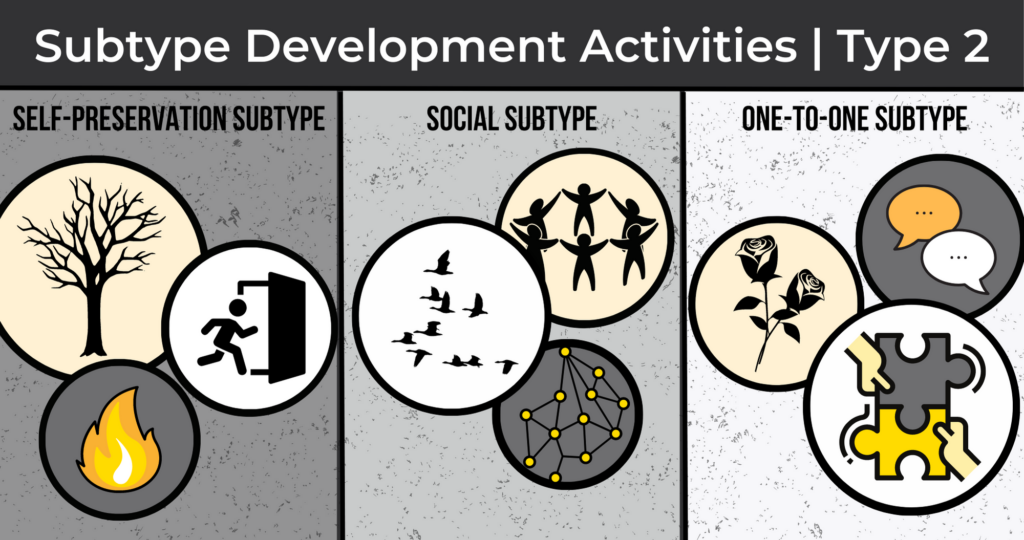There are three versions of each Enneagram type called subtypes: self-preserving subtype, social subtype and one-to-one subtype. Subtypes are formed when the emotional patterns or habits of our type, also called the type’s passion or vice, intersect and combine with one of the three basic human instincts, the instinct that is most activated within us: self-preservation instinct, social instinct or one-to-one instinct. We may have more than one activated instinct, so we could relate to two or even all three subtypes for our type.
Each instinct has specific focal areas. Individuals with that activated instinct, once it combines with the emotional pattern of our type, may move toward that instinctual area, away from that arena, or have ambivalence about that area. A way of understanding this is that the instincts by themselves are simply human and natural. However, when the activated instinct(s) combines with our type-based emotional pattern, the instinct then becomes distorted and, thus, less able to satisfy our natural needs in that instinctual area.
Here you can read about the passion or emotional habit of the type, a name for and a description of that subtype as it combines the emotional habit with that instinct, followed by one specific development idea that is particularly useful to people of that subtype. Please remember that we may have more than one active subtype, so the development activities for the additional subtype are also good for your development.
TWOS
Emotional pattern of PRIDE
Having one’s self-worth and importance integrally linked with how others respond, feeling inflated when there is a positive response and feeling deflated with a negative reaction.
Self-Preservation Two subtypes
Self-Preservation Two subtypes (“me-first/ privilege”) deny their own needs for protection, try to attract others to protect them by both being appealing and appearing to be innocent and blameless, even childlike, and are ambivalent about closeness and trusting others.
Self-Preservation Two subtype development
Notice how your fear and ambivalence in relationships hurts intimacy; develop more resilience, personal power, and capacity for intimacy.
One way to work on resilience, personal power, and intimacy:
Make a list of the ways you keep yourself small, younger than you are, more childlike. Once you do this, write down what you actually gain from doing this. Then make a list of the ways in which this behavior causes problems for you or no longer serves you. Reflect on these lists in terms for what you really want from your life right now.
Social Two subtypes
Social Two subtypes (“ambition” ) focus on helping groups more than individuals, are more intellectually oriented, and more comfortable being in visibly powerful positions than other Twos, which is a result of their desire to stand above the group but without appearing they are doing so.
Social Two subtype development
Notice how your need for power and admiration has a strategic intent that hinders closeness with others; focus on your own feelings and needs.
One way to focus on your own feelings and needs:
When you are thinking about taking a central role or making a commitment to a group that will demand a great deal of your time and energy, ask yourself why you are really thinking about doing this. Don’t settle for an answer that describes your commitment to a cause or a group purpose. Instead, ask why you are doing this for yourself.
One-to-One Two subtypes
One-to-One Two subtypes (“aggression/seduction”) are oriented to individual relationships and meeting the needs of important people and partners, attracting these others as a way to both feel important and hoping and expecting that these individuals will satisfy their needs in exchange.
One-to-One Two subtype development
Notice how you pursue intense and energetic relations with others in order to get them to meet your needs; find ways of satisfying your own needs.
One way to better satisfy your own needs:
Branch out and create more relationships in your life of varying intensities so you become far less reliant on only a few people to engage with, do things with, and converse with. This will reduce the intensity levels you expect in your relationships as well as the mutual dependency that arises when you engage only with a select set of people.
These activities are excerpts from the new additions to the soon-available 3rd edition of The Enneagram Development Guide, with over 60 development activities for each Enneagram type.
Ginger Lapid-Bogda PhD, author of nine Enneagram books, is a speaker, consultant, trainer, and coach. She provides certification programs and training tools for business professionals around the world who want to bring the Enneagram into organizations with high-impact business applications. TheEnneagramInBusiness.com | ginger@theenneagraminbusiness.com


Comments are closed.